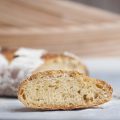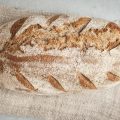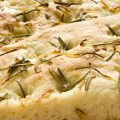Welcome to the delightful world of sourdough pan de muerto! This is a traditional Mexican bread, typically enjoyed during the Day of the Dead celebrations. But mixed with sourdough discard, this offers a unique twist on the classic pan de muerto. By incorporating the tangy flavors and benefits of sourdough fermentation, this bread not only pays homage to the ancestors but also tantalizes your taste buds with its distinct texture and flavor. Join us on this culinary adventure as we explore the rich history, cultural significance, and art of creating this sourdough-infused pan de muerto. Get ready to indulge in a truly memorable experience that brings together tradition and innovation in every delicious bite.
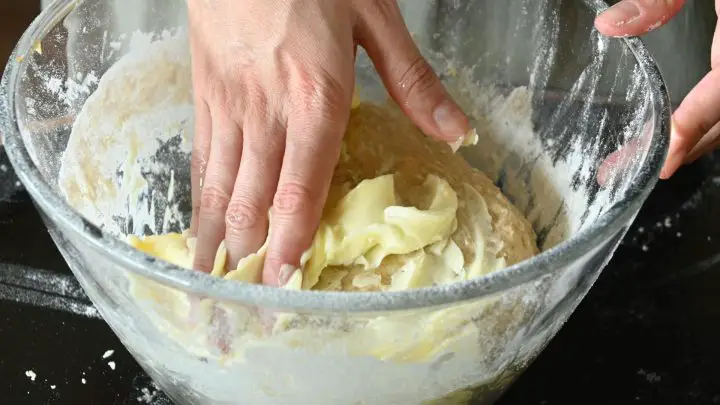
Table of Contents
- History of Pan De Muerto
- What Does Pan De Muerto Smell Like?
- Pan De Muerto Recipe
- Pan De Muerto Recipe Variations
- Tips And Tricks For Successful Sourdough Pan De Muerto
- Pairing Suggestions: Enjoying Sourdough Pan de Muerto
- Preserving and Storing Sourdough Pan de Muerto
- Day of The Dead Bread
- FAQs
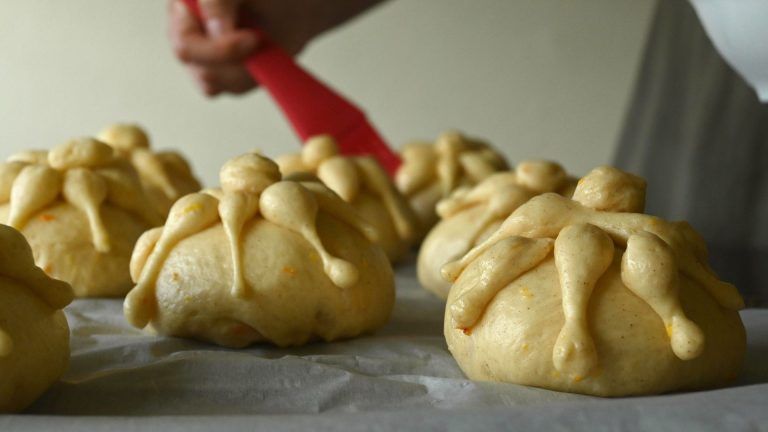
Sourdough Pan De Muerto Recipe
The recipe will guide you through the steps to create your own Pan de Muerto, allowing you to embrace the flavors and traditions of this special occasion.
Ingredients
- 4 cups all-purpose flour
- 1/2 cup granulated sugar
- 1/2 teaspoon salt
- 1 tablespoon active dry yeast
- 1/2 cup warm milk
- 1/4 cup warm water
- 1/2 cup unsalted butter, melted
- 4 large eggs
- Zest of 1 orange
- 1 teaspoon anise seeds (optional)
- Egg wash (1 egg beaten with 1 tablespoon milk)
- Granulated sugar for sprinkling
Instructions
- In a large mixing bowl, combine the flour, sugar, and salt.
- In a separate bowl, dissolve the yeast in warm water and let it sit for 5-10 minutes until frothy.
- Add the warm milk, melted butter, eggs, orange zest, and anise seeds (if using) to the yeast mixture. Whisk until well combined.
- Gradually pour the wet ingredients into the dry ingredients and mix until a soft dough forms.
- Knead the dough on a floured surface for about 10 minutes until smooth and elastic.
- Place the dough in a greased bowl, cover it with a clean cloth, and let it rise in a warm place for about 1-2 hours or until doubled in size.
- Punch down the dough and divide it into smaller portions, reserving a portion to create the decorative bone shapes.
- Shape the larger portion of dough into a round loaf with a smooth top and place it on a baking sheet lined with parchment paper.
- Take a small piece of dough and divide it into smaller portions to form bone shapes. Roll out thin strips and shape them into “bones,” placing them on top of the round loaf in a cross pattern.
- Cover the dough with a cloth and let it rise again for about 30 minutes.
- Preheat the oven to 350°F (175°C).
- Brush the risen dough with the egg wash, being careful not to disturb the bone decorations.
- Bake the Pan de Muerto for 25-30 minutes or until golden brown and cooked through.
- Remove from the oven and let it cool on a wire rack. Sprinkle with granulated sugar while still warm.
- Serve and enjoy this delectable Pan de Muerto with loved ones to honor and remember those who have passed away during the Day of the Dead festivities.
- Category: bread
- Cuisine: Mexican
History of Pan De Muerto
Pan de Muerto, or “Bread of the Dead,” carries a rich history rooted in Mexican traditions. Its origins can be traced back to the pre-Hispanic era when Aztecs and other Mesoamerican cultures revered and honored their deceased ancestors. The bread’s round shape represents the circle of life, while the bone-like decorations symbolize the departed souls.
With the arrival of Spanish conquistadors, Catholic influences merged with indigenous beliefs, giving rise to the modern tradition of Day of the Dead. Today, Pan de Muerto continues to be a cherished part of the festivities, connecting generations and serving as a delicious offering to honor and remember loved ones who have passed away.
Are You Supposed to Eat Pan De Muerto?
Yes, Pan de Muerto is meant to be eaten and enjoyed as part of the Day of the Dead celebrations. It is a delicious pastry that is traditionally shared among family and friends during this time.
While it holds symbolic meaning and is used as an offering for deceased loved ones, it is also meant to be savored and enjoyed by the living. The rich flavors and soft texture of Pan de Muerto make it a delightful treat to enjoy during this special occasion.
What Does Pan De Muerto Smell Like?
Pan de Muerto has a distinct and enticing aroma that fills the air when it is freshly baked. The combination of ingredients like orange zest, anise, and sometimes cinnamon creates a fragrant and inviting scent.
The sweet notes of the bread, along with the citrusy and warm undertones, give Pan de Muerto its characteristic smell. It is a delightful aroma that adds to the sensory experience of enjoying this traditional Mexican pastry during the Day of the Dead celebrations.
Pan De Muerto Recipe
Pan de Muerto, a traditional Mexican bread enjoyed during the Day of the Dead festivities, is a delicious treat to savor. With its distinctive round shape and bone-like decorations, this sweet and aromatic bread is a symbol of remembrance and celebration.
The recipe below will guide you through the steps to create your own Pan de Muerto, allowing you to embrace the flavors and traditions of this special occasion.
Ingredients
- 4 cups all-purpose flour
- 1/2 cup granulated sugar
- 1/2 teaspoon salt
- 1 tablespoon active dry yeast
- 1/2 cup warm milk
- 1/4 cup warm water
- 1/2 cup unsalted butter, melted
- 4 large eggs
- Zest of 1 orange
- 1 teaspoon anise seeds (optional)
- Egg wash (1 egg beaten with 1 tablespoon milk)
- Granulated sugar for sprinkling
Instructions
- In a large mixing bowl, combine the flour, sugar, and salt.
- In a separate bowl, dissolve the yeast in warm water and let it sit for 5-10 minutes until frothy.
- Add the warm milk, melted butter, eggs, orange zest, and anise seeds (if using) to the yeast mixture. Whisk until well combined.
- Gradually pour the wet ingredients into the dry ingredients and mix until a soft dough forms.
- Knead the dough on a floured surface for about 10 minutes until smooth and elastic.
- Place the dough in a greased bowl, cover it with a clean cloth, and let it rise in a warm place for about 1-2 hours or until doubled in size.
- Punch down the dough and divide it into smaller portions, reserving a portion to create the decorative bone shapes.
- Shape the larger portion of dough into a round loaf with a smooth top and place it on a baking sheet lined with parchment paper.
- Take a small piece of dough and divide it into smaller portions to form bone shapes. Roll out thin strips and shape them into “bones,” placing them on top of the round loaf in a cross pattern.
- Cover the dough with a cloth and let it rise again for about 30 minutes.
- Preheat the oven to 350°F (175°C).
- Brush the risen dough with the egg wash, being careful not to disturb the bone decorations.
- Bake the Pan de Muerto for 25-30 minutes or until golden brown and cooked through.
- Remove from the oven and let it cool on a wire rack. Sprinkle with granulated sugar while still warm.
- Serve and enjoy this delectable Pan de Muerto with loved ones to honor and remember those who have passed away during the Day of the Dead festivities.

Pan De Muerto Recipe Variations
Here are a few variations of the Pan de Muerto recipe that you can try to add your own twist to this traditional Mexican bread:
- Chocolate Pan de Muerto: Add 1/4 cup of cocoa powder to the dry ingredients for a chocolatey twist. This variation adds a rich flavor and a darker hue to the bread.
- Orange Blossom Water: Substitute 1 teaspoon of orange blossom water for the orange zest. This aromatic variation enhances the floral notes in the bread and adds a delicate fragrance.
- Almond Pan de Muerto: Add 1/2 cup of finely ground almonds to the dry ingredients. This variation provides a subtle nuttiness and a delightful texture to the bread.
- Anise-Free Pan de Muerto: If you’re not a fan of anise flavor, simply omit the anise seeds from the recipe. The bread will still have a delicious flavor with the other ingredients.
Tips And Tricks For Successful Sourdough Pan De Muerto
- Start with a strong sourdough starter: Ensure that your sourdough starter is active and healthy before using it for your Pan de Muerto. A vigorous starter will provide better flavor and rise to your bread.
- Plan ahead: Sourdough bread requires time and patience. Make sure to plan your baking schedule in advance to allow for the necessary fermentation and proofing periods.
- Maintain proper hydration: Pay attention to the hydration level of your dough. Sourdough bread benefits from slightly higher hydration, typically around 70-75%, to promote better texture and crumb.
- Autolyse for improved texture: Before adding the sourdough starter, mix the flour and water and let them rest for 30-60 minutes. This autolyse period helps develop gluten and enhances the overall texture of the bread.
- Use a dutch oven or steam during baking: To achieve a crusty and well-risen loaf, consider using a preheated dutch oven or creating steam in your oven during baking. This helps trap moisture and create a favorable environment for oven spring.
- Shape your Pan de Muerto thoughtfully: When shaping the bread, pay attention to the traditional Pan de Muerto shape, which includes a round base with “bones” or decorative elements on top. Proper shaping ensures that the bread retains its shape during baking.
- Create an egg wash for a shiny finish: Before baking, apply an egg wash made of beaten egg and a little water or milk. This will give your Pan de Muerto a glossy and appealing finish.
- Allow for proper proofing: The dough should be given sufficient time to rise and proof. Follow the recommended proofing times for your recipe, which can vary depending on ambient temperature and dough consistency.
- Preheat the oven thoroughly: Make sure your oven is properly preheated before placing your Pan de Muerto inside. Consistent and adequate heat is crucial for achieving a well-baked loaf.
- Let it cool before slicing: Once your Pan de Muerto is baked, resist the temptation to slice into it immediately. Allow it to cool completely on a wire rack before cutting into it to ensure the best texture and flavor.
- Experiment with flavors and decorations: While maintaining the traditional elements of Pan de Muerto, feel free to add your own creative twist. Consider incorporating spices like cinnamon or anise, or try different decorative patterns to personalize your bread.
Pairing Suggestions: Enjoying Sourdough Pan de Muerto
- Mexican Hot Chocolate: Pair your Sourdough Pan de Muerto with a steaming cup of Mexican hot chocolate. The rich and slightly spicy cocoa flavors complement the bread’s sweetness and add a touch of warmth to your experience.
- Café de Olla: Enjoy your Pan de Muerto with a traditional Mexican coffee called Café de Olla. This coffee is brewed with cinnamon and piloncillo (Mexican brown sugar) and has a unique, aromatic flavor that harmonizes well with the bread.
- Pumpkin Butter: Spread a generous layer of homemade pumpkin butter on your Pan de Muerto. The creamy and spiced pumpkin flavors complement the bread’s soft texture and enhance its autumnal essence.
- Orange Marmalade: The bright and tangy flavors of orange marmalade provide a delightful contrast to the sweet and rich Pan de Muerto. The combination creates a burst of flavors that will make each bite even more enjoyable.
- Mexican Vanilla Ice Cream: Indulge in a festive dessert by pairing your Sourdough Pan de Muerto with a scoop of creamy Mexican vanilla ice cream. The creamy, fragrant notes of the ice cream complement the bread’s flavors and add a refreshing element.
- Spiced Apple Compote: Prepare a warm spiced apple compote by simmering sliced apples with cinnamon, nutmeg, and a touch of honey or maple syrup. Serve it alongside your Pan de Muerto for a comforting and seasonal pairing.
- Traditional Mexican Tamales: For a savory option, enjoy your Pan de Muerto alongside traditional Mexican tamales. The contrasting flavors and textures of the bread and tamales create a balanced and satisfying meal.
- Cheese and Charcuterie: Create a rustic and flavorful platter of artisanal cheeses, cured meats, and crusty bread to accompany your Sourdough Pan de Muerto. The combination of savory and sweet flavors will delight your taste buds.
- Mexican Spiced Hot Cider: Brew a pot of spiced hot cider with cinnamon, cloves, and a hint of star anise. The warm and comforting flavors of the cider complement the Pan de Muerto, making it an ideal pairing for cool autumn days.
- Traditional Mole Sauce: Treat yourself to a taste of Mexico by pairing your Pan de Muerto with a rich and complex mole sauce. The depth of flavors in the mole enhances the bread’s taste and creates a unique gastronomic experience.
Preserving and Storing Sourdough Pan de Muerto
Preserving and storing your Sourdough Pan de Muerto properly will help maintain its freshness and flavor. Here are some tips for preserving and storing your bread:
- Cool completely: Allow your Pan de Muerto to cool completely on a wire rack before storing. This prevents moisture from getting trapped, which can lead to a soggy texture.
- Wrap in plastic or foil: Once the bread has cooled, tightly wrap it in plastic wrap or aluminum foil to protect it from drying out and to maintain its moisture.
- Store at room temperature: Sourdough Pan de Muerto is best stored at room temperature in a cool, dry place. Avoid storing it in the refrigerator, as it can accelerate staling.
- Consume within a few days: Sourdough bread is known for its shorter shelf life compared to commercial bread. It is best consumed within 2-3 days to enjoy it at its freshest. After that, it may start to lose its moisture and texture.
- Freeze for longer storage: If you have more bread than you can consume within a few days, consider freezing it. Wrap the Pan de Muerto tightly in plastic wrap and then place it in an airtight freezer bag. Frozen sourdough bread can be stored for up to 2-3 months.
- Thaw properly: When you’re ready to enjoy your frozen Pan de Muerto, remove it from the freezer and let it thaw at room temperature while still wrapped. This will help preserve its moisture. Once thawed, you can reheat it in the oven for a few minutes to refresh the crust.
- Slice as needed: To prevent the entire loaf from going stale, consider slicing the Pan de Muerto as needed instead of slicing the entire loaf at once. This allows you to enjoy freshly sliced bread throughout its storage period.
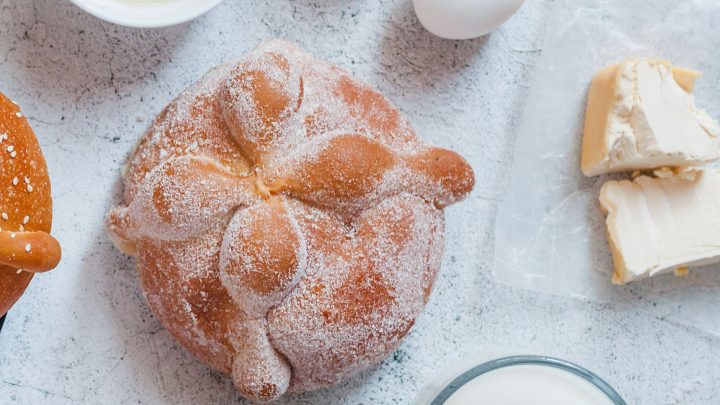
Day of The Dead Bread
In conclusion, Day of the Dead bread, or Pan de Muerto, holds a special place in the hearts and traditions of Mexico. This symbolic and flavorful bread serves as a connection between the living and the departed, a way to honor and remember loved ones.
With its distinct round shape, bone decorations, and delightful flavors, Pan de Muerto embodies the spirit of celebration and remembrance during this important cultural event.
FAQs
What Is The Meaning Behind El Pan De Muerto?
El Pan de Muerto, or “Bread of the Dead,” is a traditional Mexican pastry with a deep cultural meaning. It is prepared and enjoyed during the Day of the Dead celebrations, honoring deceased loved ones. The round shape symbolizes the circle of life, and the decorative bones represent the departed souls. It is a delicious and symbolic treat that connects families and communities in remembrance and celebration.
What Does Pan De Muerto Taste Like?
Pan de Muerto is a flavorful and aromatic pastry with a unique taste. It is slightly sweet and enriched with ingredients like orange zest, anise, and sometimes hints of cinnamon. The texture is soft and tender, with a light crumb. Its delicate flavors and richness make it a delightful treat during the Day of the Dead festivities.

